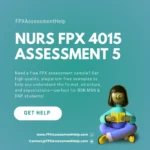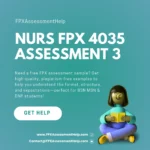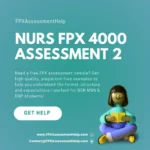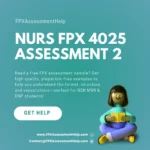NURS FPX 4000 Assessment 5 Analyzing a Current Health Care Problem or Issue
Student Name
Capella University
NURS-FPX4000 Developing a Nursing Perspective
Prof. Name
Date
Analyzing a Current Health Care Problem or Issue
Describing the Healthcare Problem: Health Literacy
The healthcare problem of low health literacy is a significant issue with pressing importance, as it negatively impacts both clinical outcomes and healthcare system operations. Research from the National Assessment of Adult Literacy reveals that most American adults struggle to understand and use health information required for making knowledgeable decisions. Around 36% of adults demonstrated only basic or below-basic health literacy skills, highlighting the importance of addressing this issue (Saleem & Jan, 2024). People with limited health literacy tend to misunderstand the meaning of medical directions, avoid preventive tests, and end up in the hospital for treatable diseases.
The healthcare system bears financial consequences from these challenges because patients require extended emergency services and extended hospital stays, and develop additional medical complications. Research by Shahid et al. (2022) estimates that low health literacy results in annual economic losses ranging from $106 billion to $238 billion, underscoring its substantial impact on national healthcare expenditures.
The need to address low health literacy becomes crucial because it establishes a direct relationship with patient safety, health equity, and quality of care delivery. Patients in healthcare who lack an understanding of their medical condition, treatment procedures, and disease management often have a reduced capacity to take control of their medical care. Patients who lack health literacy tend to experience poorer health outcomes, lower satisfaction, and higher hospital readmission rates. The combination of patient education, clear communication, and supportive technology enables improvements in health literacy, empowering patients to become more informed while strengthening their relationships with providers, ultimately resulting in more effective and equitable healthcare delivery (Fitzpatrick, 2023).
Analysis of Health Literacy as a Health Problem
Low health literacy is a complex healthcare issue with multiple contributing factors, including education level, language barriers, cultural differences, and cognitive limitations. While its negative effects on patient outcomes and healthcare costs are well-documented, there are still areas that require further exploration. For example, there is limited research on how digital health tools, such as patient portals and mobile apps, impact individuals with low literacy levels (Carini et al., 2021). Additionally, the effectiveness of various health literacy interventions across diverse populations, particularly among older adults, immigrants, and those with limited English proficiency, remains uncertain. Understanding which strategies are most effective for specific groups is crucial for designing targeted and inclusive health education programs (Marjadi et al., 2023).
Another area requiring further research is the impact of healthcare providers’ communication skills on health literacy outcomes. Although training programs in plain language and teach-back methods exist, more evidence is needed to evaluate their long-term impact on patient comprehension and adherence. There is also a lack of standardized tools to measure health literacy in clinical settings, which makes it challenging to identify patients at risk and monitor their improvement. Future studies should focus on developing reliable assessment tools, examining the role of technology, and identifying culturally appropriate communication strategies to ensure all patients can access, understand, and use health information effectively (Kiran, 2023).
Potential Solutions
The issue of low health literacy requires multiple proposed solutions, including provider communication training, the development of simplified and culturally appropriate health materials, and the integration of digital health technology. The recommendation to train healthcare providers to use plain language and visual aids, combined with the teach-back method, represents a standard approach to enhance patient care. The teach-back method enables providers to assess patient comprehension and make necessary adjustments to their explanations, thereby improving patient engagement and understanding (Shersher et al., 2021).
The creation of easy-to-understand written communications, including translated materials and pictorial instructions, serves patients who struggle with reading or have limited English proficiency (Shan et al., 2022). Digital health technologies, including mobile apps, telehealth platforms, and patient portals, enable patients to gain independent control over their healthcare management and receive personalized information and reminders (Cancela et al., 2021).The approaches align with some scholarly viewpoints from the Capella University Library, yet demonstrate clear distinctions between them. Forsey et al. (2021) establish that primary care practitioners require communication training because effective communication is an essential element for patient comprehension and the delivery of medical care.
Kemp et al. (2020) center their discussion on digital health tools because they provide efficient and accessible care, especially to tech-oriented patients. The benefits of digital health solutions should be utilized in conjunction with traditional, effective communication methods, rather than replacing them. Patients from older adult categories, as well as underserved populations and those residing in rural areas, often encounter obstacles when accessing digital health information and understanding its content. Digital tools will not achieve equitable improvements in health literacy unless they address fundamental issues first.
The primary solution to provider communication training exhibits beneficial characteristics, albeit with its constraints. The technique enhances patient-provider trust and proves cost-effective, while functioning well in various healthcare settings. The system enables care delivery to patients of all literacy abilities while creating a patient-focused healthcare setting (Shersher et al., 2021). However, there are also barriers. The implementation of provider training requires extensive periods, as providers may adopt these practices inconsistently, as the outcomes rely on both personal motivation and effective communication methods (Tang et al., 2022). Health literacy improvement remains most effectively supported by communication training, which faces minimal obstacles in its implementation. Health materials that utilize clear language, combined with digital tools, form an effective approach to enhance understanding and improve patient adherence and health outcomes.
The Impact of Ethical Principles on Solutions
The training of healthcare providers presents an effective method to enhance health literacy, supporting core ethical principles, including beneficence and non-maleficence, alongside autonomy and justice. Beneficence as a principle of ethics requires medical providers to enhance patient comprehension of their care to achieve better clinical results together with higher patient satisfaction. Studies by Religioni et al. (2025) demonstrate that improved provider-patient communication reduces nonadherence to treatments and helps patients manage persistent health conditions, thereby enhancing their overall well-being. The avoidance of harm through non-maleficence principles becomes possible through truthful communication, as it reduces the occurrence of miscommunications and medication errors, and prevents complications stemming from misunderstandings of medical instructions.
Medical staff demonstrate respect for patient autonomy by providing clear information that enables individuals to make informed healthcare decisions. Patients cannot exercise autonomy in healthcare choices unless they receive full comprehension of their medical situation along with treatment options. Healthcare providers use simple explanations, along with teach-back techniques, to ensure that patients receive a comprehensive understanding of the informed consent process. The solution promotes the equitable distribution of resources and healthcare services, which constitutes justice. Through standard communication training, healthcare professionals provide equivalent treatment to every patient irrespective of their literacy abilities or cultural backgrounds. Health equity requires health literacy as its critical framework, while improved communication serves as a fundamental mechanism for lowering disparities according to Burks et al. (2024).
For healthcare organizations to implement effective provider communication training, they must allocate time and resources to educate staff, integrate literacy-sensitive communication protocols into clinical workflows, and establish an ongoing evaluation and feedback system. There is also an ethical bias to consider. Providers need to be trained to recognize their assumptions about patients’ abilities and to avoid stereotyping patients based on factors such as age, race, language, or education level. Torres et al. (2022) note that unconscious bias can affect provider-patient interactions and contribute to care inequities. Reflective practice and inclusive training help address these biases, allowing for the delivery of ethical, patient-centered care.
Sphere of Care
Provider communication training for improving health literacy yields substantial health literacy outcomes throughout the entire care process, particularly during the management of chronic diseases. Patients who suffer from diabetes, along with hypertension and asthma, need ongoing self-care practice combined with adjustments to their lifestyle and strict medication compliance. Patients understand their health conditions better when healthcare providers use simple language, along with teach-back approaches, while approaching communication with cultural sensitivity. Healthcare providers who use clear language, along with teach-back techniques and cultural sensitivity, when communicating will assist patients in following their treatment plans and detecting early warning signs. According to Becker et al. (2021), effective communication serves as a direct link between improved chronic disease outcomes and reduced hospital admissions, while enhancing patients’ quality of life and overall treatment success.
Effective communication skills enable people to participate in preventive behaviors, thereby enhancing wellness and disease prevention activities. Higher levels of health literacy increase the likelihood that patients will participate in testing programs, vaccinations, and educational health initiatives. Healthcare providers who clearly and straightforwardly explain the importance to patients will achieve better results. Patients who receive clear information tend to take actions that minimize their susceptibility to both chronic and acute medical conditions. The implementation of communication training serves both current needs and future protection against health problems, as it stands as an essential preventive approach (Burks et al., 2024).
Conclusion
In conclusion, training providers in communication is a crucial solution to improve health literacy, enhance patient care, and reduce healthcare disparities. Healthcare providers can improve chronic disease management, promote wellness, and prevent ill health by enabling patients to understand the information they receive. Communication barriers are also addressed in ethical principles such as beneficence, non-maleficence, autonomy, and justice, which will ensure equitable care for all patients. Although implementation is not without challenges, the long-term benefits of improved health outcomes, increased patient satisfaction, and decreased healthcare costs make this approach imperative for improving the healthcare system.
References
Becker, C., Zumbrunn, S., Beck, K., Vincent, A., Loretz, N., Müller, J., Amacher, S. A., Schaefert, R., & Hunziker, S. (2021). Interventions to improve communication at hospital discharge and rates of readmission. JAMA Network Open, 4(8). https://doi.org/10.1001/jamanetworkopen.2021.19346
Burks, C. A., Nosayaba Osazuwa-Peters, & Brenner, M. J. (2024). Health literacy is health equity−how better communication in head and neck cancer translates into better outcomes. JAMA Otolaryngology–Head & Neck Surgery, 150(8), 724–724. https://doi.org/10.1001/jamaoto.2024.1570
NURS FPX 4000 Assessment 5 Analyzing a Current Health Care Problem or Issue
Cancela, J., Charlafti, I., Colloud, S., & Wu, C. (2021). Digital health in the era of personalized healthcare. Digital Health, 7–31. https://doi.org/10.1016/b978-0-12-820077-3.00002-x
Carini, E., Villani, L., Pezzullo, A. M., Gentili, A., Barbara, A., Ricciardi, W., & Boccia, S. (2021). The impact of digital patient portals on health outcomes, system efficiency, and patient attitudes: Updated systematic literature review. Journal of Medical Internet Research, 23(9), 1–20. https://doi.org/10.2196/26189
Fitzpatrick, P. J. (2023). Improving health literacy using the power of digital communications to achieve better health outcomes for patients and practitioners. Frontiers in Digital Health, 5(1). https://doi.org/10.3389/fdgth.2023.1264780
Forsey, J., Ng, S., Rowland, P., Freeman, R., Li, C., & Woods, N. N. (2021). The basic science of patient–physician communication: A critical scoping review. Academic Medicine, 96(11S), S109–S118. https://doi.org/10.1097/acm.0000000000004323
NURS FPX 4000 Assessment 5 Analyzing a Current Health Care Problem or Issue
Kemp, E., Trigg, J., Beatty, L., Christensen, C., Dhillon, H. M., Maeder, A., Williams, P. A. H., & Koczwara, B. (2020). Health literacy, digital health literacy, and the implementation of digital health technologies in cancer care: The need for a strategic approach. Health Promotion Journal of Australia, 32(S1), 104–114. https://doi.org/10.1002/hpja.387
Kiran, A. (2023). English Language Assessment: Innovations, Validity, and Reliability. Journal of International English Research Studies (JIERS), ISSN: 3048-5231, 1(2), 1-8.
Marjadi, B., Flavel, J., Baker, K., Glenister, K., Morns, M., Triantafyllou, M., Strauss, P., Wolff, B., Procter, A. M., Mengesha, Z., Walsberger, S., Qiao, X., & Gardiner, P. A. (2023). Twelve tips for inclusive practice in healthcare settings. International Journal of Environmental Research and Public Health, 20(5). https://doi.org/10.3390/ijerph20054657
Religioni, U., Barrios-Rodríguez, R., Requena, P., Borowska, M., & Ostrowski, J. (2025). Enhancing therapy adherence: Impact on clinical outcomes, healthcare costs, and patient quality of life. Medicina, 61(1), 153–153. https://doi.org/10.3390/medicina61010153
Saleem, S. M., & Jan, S. S. (2024). Navigating the infodemic: Strategies and policies for promoting health literacy and effective communication. Frontiers in Public Health, 11. https://doi.org/10.3389/fpubh.2023.1324330
Shan, Y., Ji, M., Dong, Z., Xing, Z., Wang, D., & Cao, X. (2022). The chinese version of the patient education materials assessment tool for printable materials (PEMAT-P): Translation, adaptation, and validation study (preprint). Journal of Medical Internet Research. https://doi.org/10.2196/39808
Shersher, V., Haines, T. P., Sturgiss, L., Weller, C., & Williams, C. (2021). Definitions and use of the teach-back method in healthcare consultations with patients: A systematic review and thematic synthesis. Patient Education and Counseling, 104(1), 118–129. https://doi.org/10.1016/j.pec.2020.07.026
Tang, C., Wang, A., & Yan, J. (2022). Exploring motivations and resistances for implementing shared decision‐making in clinical practice: A systematic review based on a structure–process–outcome model. Health Expectations. https://doi.org/10.1111/hex.13541
Torres, T. K., Chase, D. M., Salani, R., Hamann, H. A., & Stone, J. (2022). Implicit biases in healthcare: implications and future directions for gynecologic oncology. American Journal of Obstetrics and Gynecology, 227(1). https://doi.org/10.1016/j.ajog.2021.12.267





